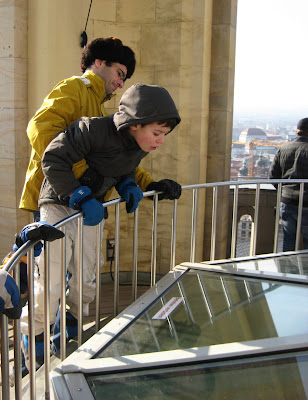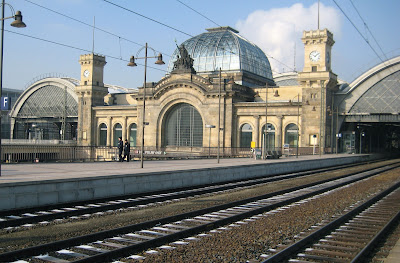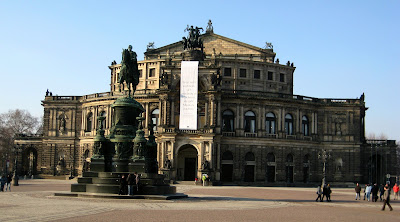The 8:30 train on Tuesday morning pulled into Dresden's Hauptbahnhof two hours and twenty minutes later, leaving us much of the beautiful day to explore the city.
We were all excited to see our old friend ampelmann (traffic light man), the East German crossing signal guy, at the crosswalks. According to an article in Deutche Welle, ampelmann "enjoys the privileged status of being one of the sole features of communist East Germany to have survived the end of the Iron Curtain with his popularity unscathed."
Here he is balancing atop a bicycle, the clever fellow.
After checking into the A&O Hostel & Hotel (an easy walk from the train station), we did a self-guided Lonely Planet tour through the Altstadt (Old Town) the site of much devastation following the Allied bombing campaign in February 1945.
Kreuzkirche (Church of the Holy Cross), first dedicated in 1388, has been destroyed and rebuilt five times since the 1400s. Following 1945, the church was rebuilt again and opened in 1955.
It's a massive, open, spare space inside. The choice to leave the Baroque ornamentation that survived the bombing but rebuild the rest in rough plaster gives it a lofty, ethereal feel.
The church's organ. You can get a sense of the scale by noting Karl (in a yellow shell) and another guy standing near the door of the archway.
The detail left in the archway is a little eerie. We'd told the boys about Dresden's WWII history, but visiting the church left a bigger impression than any stories we could tell. The four of us had an interesting conversation about choices that people/countries make in wartime and the consequences of those choices.
We made our way around Town Hall and over to Neumarkt (New Market) to the Frauenkirche (Church of our Lady), a Lutheran church built between 1726-43 and one of the most important Protestant churches in Europe. The significance of the church itself as well as its gorgeous Baroque design made it a beloved symbol of Dresden. It was also flattened as a result of the Allied air raid, but the rubble was left to stand as a memorial to the bombing victims. The statue of Martin Luther, first erected in 1885, survived the attack, as this picture from the Web shows.
A political science professor (also on sabbatical) made this note in his blog.
The initial response of Dresdeners was to rebuild it. The preference of the East German communists was to leave it as it was - the ruins being a reminder of the consequences of war. The symbolism of Luther’s church lying in ruins was also no doubt appealing to the GDR's official atheists.In the '90s, money was raised to reconstruct the church with the goal of completing it for the city's 800th anniversary in 2006. It was reconsecrated in October 2005.
The original bricks (the dark ones) were excavated and used when possible, serving as a reminder of the church's recent history.
Unlike the Kreuzkirche, there's nothing spare about the Frauenkirche's interior.
(Got this picture and the next off the Web -- I wish I could say they were mine! Signs indicated that photography inside the sanctuary was prohibited.) I later wrote in my journal,
When you enter this church, you don't think "bomb victim" or "phoenix rising." You think "baby's nursery" -- all soft curves with yellow, pink marble, robin's egg blue, and (ooo, shiny!) gold. It's joyful and elaborate, with light pouring in like water filling a glass. It's homey and chatty, a conversation, not a lecture. The balconies rise up and talk to each other rather than bow to the maestro. And the outrageously ornate baroque altar starts your gaze up and up, pulling you into a dizzying tailspin as your eye heads for the dome, the cupola, the heavens.
We climbed to the Frauenkirche's cupola, because we can't resist a good climb and a good view. What was different about climbing this tower was the obvious care that was taken to make it comfortable ~
Hand rails line wide ramps which rise at a relatively gentle grade.
Plenty of places to stop and rest along the way. These are pretty clearly 20th century features.
At the top we were rewarded with stunning views of Dresden, which in the 1600s earned in the nickname "Florence on the Elbe" because of its cultural significance in art, music, and architecture.
Looking west toward the Schloss (Palace) and the Catholic Hofkirche (Church of the Court). You can see Augustusstraße (Augustus Street) the street that leads to Schlossplatz and is famous for its 102m mural of a royal procession.
The northern view includes the Albertinum, an art museum, and the Kunstakademie (Academy of Arts).
 |
| "Our hotel? It's right over there." |
The towers of Neues Rathaus (New Town Hall) and Kreuzkirche, to the south.
 |
| Us! |
 |
| "Whoa. That's a long way down." |
Other peaks into the church ~
We headed down Augustusstraße, taking in the Procession of Princes.
The mural was painted between 1870 and 1876. In 1906 and 1907 it was transferred to almost 25,000 Meissen porcelain tiles, which survived the 1945 bombings.
It depicts the princes and rulers from the house of Wettin beginning with Konrad the Great in 1127 through Friedrich August III, Saxony's last king, who ruled until 1918.
All this history made us thirsty. Pfunds Molkerei, deemed the world's most beautiful dairy shop by the Guinness Book of World Records,
not only dazzles the eye with its elaborate floor-to-ceiling Villeroy & Boch porcelain tiles ...
They also make a mean milkshake!
Ben and Garrett went along patiently (for the most part) with our historic walking tour, knowing that good behavior would be rewarded at the day's end.
From the moment the boys spotted this playground in the late morning,
Karl and I fended off pleas of "can we go to the playground now?!"
Did you really think we could get them to go to those churches and old buildings without dangling a carrot as our final stop of the afternoon?
Turns out, we were all ready to burn a little energy.
The next morning we started right off with something for the kids ~ The Hygiene Museum.
That's right. In Dresden, you'll find the interactive kindermuseum in the Hygiene Museum. (Because kids are all about hygiene.) The focus is on the five senses.
We took turns trying to find our way through a really confusing mirror maze. There were more than a couple of noggin-reflection collisions.
Karl sedated the masses with a soothing rendition of Brahms' lullaby.
Normally I wouldn't think it was a good idea to don a mask that others had worn, but for goodness sake! This was The Hygiene Museum! I'm sure that little stomach bug Garrett weathered later in the week was purely coincidental.
After lunch we visited the Zwinger, home to six museums. We assumed the boys would have the patience for one exhibit, but which one? The Old Masters Gallery was ruled out immediately, along with the Porcelain Collection. The Natural History Museum and the Museum of Minerology and Geology certainly would have had appeal, but we were hoping for something a little different. The globes and timepieces in the Mathematics and Physics Salon were probably really cool. But ultimately, the choice was easy.
Off to the Rüstkammer (Armory) and its collection of ceremonial weapons. (Photography was again prohibited, so I got these photos from this art blog.)
We were all fascinated by the detail on the handles of swords, scabbards, and pistols.
And there were many examples of armor for knights and horses. I like the pseudo-unicorn detail on this guy.
We popped in one last church, the Catholic Hofkirche (Church of the Court), just kitty-corner to the Zwinger.
In 1697 Augustus II ("the Strong") converted to Catholicism so that he would be eligible to become King of Poland. His son, Augustus III, had the Hofkirche built in the mid-1700s to counterbalance the Protestant influence of the region. The Hofkirche is the largest church in Saxony.
The church has four burial vaults which house the remains of kings and princes of Saxony. An urn containing the heart of Augustus the Strong was buried here. His body was buried in Krakow, Poland.
Reconstruction on the Hofkirche began soon after WWII but it wasn't completed until 1987.
The Hofkirche was built right next to the Palace,
and included a skywalk for royalty. They could get to mass without having to rub elbows with the riff-raff.
By this point, we really had exhausted our children's patience for history and architecture.
Back to the playground.
And then to our train, the Carl Maria von Weber bound for Prague.
More pics, if you're so inclined ~
The Zwinger's Crown Gate. We saw a lot of scaffolding all around the city, especially at the Zwinger. Its reconstruction was complete in 1995, but apparently it was due for a facelift.
 |
| More fun with mirrors |
The Semperoper (Semper Opera House). Richard Strauss, Carl Maria von Weber and Richard Wagner are among the composers who premiered operas here. The banner hung on Tuesday but was gone by Wednesday.
Waiting for the tram to Pfunds Molkerei.
Here it is!
 |
| "Garrett? No running. It's a church." "Oh, right." |
 |
| Schloss archway |
 |
| Just having a look. |
Inside the massive Zwinger courtyard
 |
| The Rampart Pavilion topped by Hercules. (Dresden is big on Hercules -- he's on top of Town Hall, too.) |
This is one impressive playground. And, of course, the highlight of the boys' trip.
Charming detail at the dairy shop's WC
 |
| Semperoper |
With the banner removed, we could check out more detail in the façade.
 |
| Garrett decided the only thing this Frauenkirche model lacked was Lego mini-figures. |
 |
| Baroque details on the Zwinger |
 |
| Cherubs on a building in Neumarkt |
 |
| The Schloss |
"Oh look, it's one of those poof-ball trees."
"EWWW!!!"
"I said 'poof' ball trees, Ben."
"Oh."
 |
| Heading for home |



























































Marvelous memories.
ReplyDeleteWell, crap. Now I want to go to Dresden.
ReplyDelete@ A ~ We're here another four months ...
ReplyDelete@ Joe ~ for the most part! :)
ReplyDeleteMarvelous photos!!Jonesin' for some international travel.... last time I was in East Germany the wall was still up- and we had to drink champagne with fresh strawberries in it to use up the money they made us exchange at the border. Just had to... :) a
ReplyDelete@ a ~ Back in the day, Karl used the money from his obligatory exchange to buy old music scores. But, you know. That's Karl. :)
ReplyDeleteThe scores were actually brand spankin' new. It's the music in them that was old.
ReplyDeleteKarl
Katie,
ReplyDeleteI love the photos of the churches in Dresden and have been catching up on some of the rest of your blog. Also I enjoyed your "interview" with your husband. The boys seem to be immersed in all kinds of interesting activities too.
Love,
Cousin Diane in NH
Glad to see you got some pictures of that playground. I spent about 1/2 day in Dresden on my way to Berlin a couple months ago, and that is one of the things that really stood out. I didn't have time to really stop and check it out or get any pictures, but that was one of the most impressive playgrounds I've seen. If only they had something like that where I grew up, and I doubt you would find anywhere in the US that would allow something of that scale and construction now.
ReplyDeleteI didn't know about all of the museums in the Zwinger though. I'll have to go back sometime. I only really passed through Dresden on a whim to check out the Frauenkirche and didn't know much else about the city.
Anonymous ~ Our kids were certainly relieved that we found that playground, although it was pretty cold when we visited Dresden -- our interest in spending long periods of time outdoors was limited.
ReplyDeleteDresden's a lovely city, and the proximity from Prague made it an easy quick trip for us. It hadn't been on my Must Do list for our year in Europe, but I'm glad we made it there.